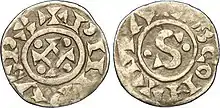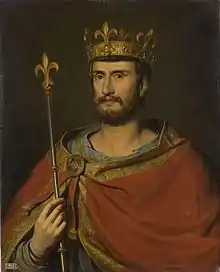Philip I of France
Philip I (c. 1052 – 29 July 1108), called the Amorous (French: L’Amoureux),[1] was King of the Franks from 1060 to 1108. His reign, like that of most of the early Capetians, was extraordinarily long for the time. The monarchy began a modest recovery from the low it had reached during the reign of his father, Henry I, and he added the Vexin region and the viscountcy of Bourges to his royal domaine.
| Philip I | |
|---|---|
 Philip I's seal | |
| King of the Franks | |
| Co-reign Solo-reign | 23 May 1059 – 4 August 1060; 4 August 1060 – 29 July 1108 |
| Coronation | 23 May 1059 |
| Predecessor | Henry I |
| Successor | Louis VI |
| Regent | Anne of Kiev and Baldwin V of Flanders (1060–1067) |
| Born | 23 May 1052 Champagne-et-Fontaine |
| Died | 29 July 1108 (aged 56) Melun |
| Burial | |
| Spouse | Bertha of Holland Bertrade de Montfort |
| Issue more... | Constance, Princess of Antioch Louis VI of France Cecile, Princess of Galilee |
| House | Capet |
| Father | Henry I of France |
| Mother | Anne of Kiev |
Early life
Philip was born c. 1052 at Champagne-et-Fontaine, the son of Henry I and his wife Anne of Kiev.[2] Unusual for the time in Western Europe, his name was of Greek origin, being bestowed upon him by his mother. Although he was crowned king at the age of seven,[3] until he turned fourteen (1066) his mother acted as regent, the first queen of France ever to do so. Baldwin V of Flanders also acted as co-regent.[4]
Personal rule

Following the death of Baldwin VI of Flanders, Robert the Frisian seized Flanders.[5] Baldwin's widow, Richilda, requested aid from Philip, who was defeated by Robert at the battle of Cassel in 1071.[4]
Philip appointed Alberic first Constable of France in 1060. A great part of his reign, like his father's, was spent putting down revolts by his power-hungry vassals. In 1077, he made peace with William the Conqueror, who gave up attempting the conquest of Brittany.[6] In 1082, Philip I expanded his demesne with the annexation of the Vexin,[4] in reprisal against Robert Curthose's attack on William's heir, William Rufus. Then in 1100, he took control of Bourges.[7] Philip expanded the royal demesne by incorporating the monasteries of Saint-Denis and Corbie.[8]
It was at the aforementioned Council of Clermont that the First Crusade was launched. Philip at first did not personally support it because of his conflict with Urban II. Philip's brother Hugh of Vermandois, however, was a major participant.
In 1107, Pope Paschal II met Philip and the future Louis VI in Saint-Denis, cementing a century-long alliance between the kingdom of France and the papacy against the Holy Empire.
Personal life
Philip first married Bertha of Holland in 1072.[9] Although the marriage produced the necessary heir, Philip fell in love with Bertrade de Montfort, the wife of Fulk IV, Count of Anjou. He repudiated Bertha (claiming she was too fat) and married Bertrade on 15 May 1092.[10] In 1094 following the synod of Autun, he was excommunicated by the papal representative, Hugh of Die, for the first time;[11] after a long silence, Pope Urban II repeated the excommunication at the Council of Clermont in November 1095.[12] Several times the ban was lifted as Philip promised to part with Bertrade, but he always returned to her; between 1100 and 1104, Philip was reconciled with the papacy and he was absolved in 1104, when he made a public penance and must have kept his involvement with Bertrade discreet.[13] In France, the king was opposed by Bishop Ivo of Chartres, a famous jurist.[14]
Death
.jpg.webp)
Philip died in the castle of Melun and was buried per his request at the monastery of Saint-Benoît-sur-Loire[15] – and not in St Denis among his forefathers. He was succeeded by his son, Louis VI, whose succession was, however, not uncontested. According to Abbot Suger:[16]
… King Philip daily grew feebler. For after he had abducted the Countess of Anjou, he could achieve nothing worthy of the royal dignity; consumed by desire for the lady he had seized, he gave himself up entirely to the satisfaction of his passion. So he lost interest in the affairs of state and, relaxing too much, took no care for his body, well-made and handsome though it was. The only thing that maintained the strength of the state was the fear and love felt for his son and successor. When he was almost sixty, he ceased to be king, breathing his last breath at the castle of Melun-sur-Seine, in the presence of the [future king] Louis... They carried the body in a great procession to the noble monastery of St-Benoît-sur-Loire, where King Philip wished to be buried; there are those who say they heard from his own mouth that he deliberately chose not to be buried among his royal ancestors in the church of St. Denis because he had not treated that church as well as they had, and because among those of so many noble kings, his own tomb would not have counted for much.

Issue
Philip's children with Bertha were:
- Constance (1078 – 14 September 1126), married Hugh I of Champagne before 1097[17] and then, after her divorce, to Bohemund I of Antioch in 1106.[18]
- Louis VI of France (1 December 1081 – 1 August 1137).[18]
- Henry (1083 – died young).
Philip's children with Bertrade were:
- Philip, Count of Mantes (1093 – fl. 1123),[19] married Elizabeth, daughter of Guy III of Montlhéry[20]
- Fleury, Seigneur of Nangis (1095 – July 1119)[21]
- Cecile (1097 – 1145), married Tancred, Prince of Galilee[22] and then, after his death, to Pons of Tripoli.[23]
References
- Norwich, John J. (2 October 2018). A History of France. Atlantic Monthly Press. ISBN 9780802146700.
- Bradbury 2007, p. 111.
- Strickland 2016, p. 342.
- Hallam 1980, p. 50-51.
- Nicholas 1999, p. 115.
- Petit-Dutaillis 1936, p. 81.
- Shepherd 2003, p. 13.
- Gabriele 2020, p. 500.
- Bradbury 2007, p. 114.
- Bradbury 2007, p. 119; Gabriele 2020.
- Bradbury 2007, p. 119.
- Somerville 2011, p. 118.
- d'Avray 2014, p. 47.
- Rolker 2009, p. 16.
- Brown 1990, p. 807.
- Abbot Suger.
- Paul 2012, p. 38.
- Huscroft 2016, p. xi.
- Power 2004, p. 85.
- Bradbury 2007, p. 131.
- McDougall 2017, p. 155.
- McDougall 2017, p. 159.
- Hodgson 2007, p. 217.
Sources
- d'Avray, David, ed. (2014). "Philip I of France and Bertrade". Dissolving Royal Marriages: A Documentary History, 860–1600. Cambridge University Press.
- Bradbury, Jim (2007). The Capetians: The History of a Dynasty. Bloomsbury Publishing.
- Brown, Elizabeth A. R. (1990). "Authority, the Family, and the Dead in Late Medieval France". French Historical Studies. 16 (4 Autumn): 803–832. doi:10.2307/286323. JSTOR 286323.
- Gabriele, Matthew (2020). "Not so strange bedfellows: new thoughts on King Philip I of Francia's marriage to Bertrada of Montfort". Journal of Medieval History. Taylor & Francis. 46 (5): 499–512. doi:10.1080/03044181.2020.1814393. ISSN 0304-4181.
- Hallam, Elizabeth (1980). Capetian France: 987–1328. Longman Group Ltd.
- Hodgson, Natasha R. (2007). Women, Crusading and the Holy Land in Historical Narrative. The Boydell Press.
- Huscroft, Richard (2016). Tales from the Long Twelfth Century: The Rise and Fall of the Angevin Empire. Yale University Press.
- McDougall, Sara (2017). Royal Bastards: The Birth of Illegitimacy, 800–1230. Oxford University Press.
- Nicholas, Karen S. (1999). "Countess as Rulers in Flanders". In Evergates, Theodore (ed.). Aristocratic Women in Medieval France. University of Pennsylvania Press.
- Paul, Nicholas L. (2012). To Follow in Their Footsteps: The Crusades and Family Memory in the High Middle Ages. Cornell University Press. ISBN 978-0-801-45097-6. OL 25307863M.
- Petit-Dutaillis, C. (1936). The Feudal Monarchy in France and England:From the 10th to the 13th Century. Translated by Hunt, E.D. Routledge. OL 27789341M.
- Power, Daniel (2004). The Norman Frontier in the Twelfth and Early Thirteenth Centuries. Cambridge University Press.
- Rolker, Christof (2009). Canon Law and the Letters of Ivo of Chartres. Cambridge University Press.
- Shepherd, Jonathan (2003). "The 'muddy-road' of Odo Arpin from Bourges to La Charitie-sur-Loire". In Edbury, Peter; Phillips, Jonathan (eds.). The Experience of Crusading. Vol. 1. Cambridge University Press.
- Abbot Suger. "XIII: Of the death of King Philip". Life of King Louis the Fat. Translated by Dunbabin, Jean – via Internet History Sourcebooks Project (Fordham University).
- Somerville, Robert (2011). Pope Urban II's Council of Piacenza. Oxford University Press.
- Strickland, Matthew (2016). Henry the Young King, 1155–1183. Yale University Press.
External links
- . Encyclopædia Britannica. Vol. XVIII (9th ed.). 1885. p. 743.